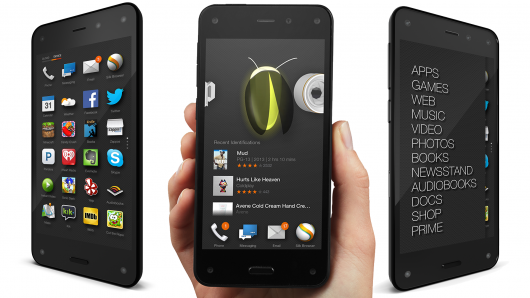Amazon has officially announced its Fire Phone. It's a good phone, with a design and software features that should give Apple and Samsung some interesting thoughts and ideas. How far Amazon will wander down the path of building its own hardware, however, is an interesting question. Will Amazon go so far as to share some of the core software of Fire Phone so it can grow its own business?
Amazon has added two cool new features (currently) unique to the Fire Phone. Dynamic Perspective, the much touted 3D "stereo cameras that see your face" feature takes advantage of all the sensors built into the phone to allow gestures such as "peek" to show Yelp ratings in maps , a 90-degree left-and-right look from a seat in Stubhub stadium view, and game movement to look around corners and objects. Other 3D gestures include tilt to scroll between panels, swivel for access to notifications and quick actions. There's also an auto-scroll feature for one-handed reading.
I'm interested to see how 3D gestures will work between generations. Younger ones brought up on the Nintendo Wii and Microsoft's Xbox Kinect shouldn't have any problems embracing and adopting the new user interface, but I'm worried that older folks like myself might get annoyed at all the wrist movement. I'm also concerned that I might shake my phone into doing something I don't intend, just because I tend to gesticulate when I get annoyed.

Image via gizmag.com
The 3D movement features are not likely to generate a lot of demand, as Apple and Google will look at what works and apply those features to their respective operating system releases. Alternatively, iOS and Android will get more limited but "better" 3D gesture functions without using so much hardware and software.
Firefly is the software magic that I suspect we've all been waiting for – and one that Apple or Google should have come up with before now. Pressing the Firefly button on the Fire Phone triggers an identification process to dig out phone numbers, Web, and email addresses on the printed text of posters, magazines, and business cards.
But it's the splicing of search more directly into content purchase that Amazon is leveraging. The Firefly X-Ray feature powered by IMDB recognizes over 240,000 movies and TV episodes, plus 160 live TV channels to show info on actors, plot details, and other content. You can use it to add titles to a watch list or download a show (via Amazon's service, of course) to watch later. For music, Firefly recognizes songs and can access artist information, play related songs, download albums directly to the Fire phone, or add them to a Wish List to purchase later one. Both StubHub and iHeartRadio are Firefly-enabled apps, so you can create radio stations based on an identified artist or find tickets for their next show.
And if that wasn't enough? Firefly recognizes over 70 million products, including household items, books, DVDs, CDs, video games and more. It will pull up product details, add items to your Wish List or you can place an order on Amazon straight from your Fire phone. LG and other manufacturers of "smart" appliances probably took a big step backwards today, because you can whip out a $199 phone to make a grocery list that encompasses the refrigerator, pantry, garage, and bathroom without being dependent upon an RFID reader and packaging… or having to worry about networking your 'fridge, for that matter.
There's no reason why Amazon couldn't splice Firefly into upgraded apps for Android. FireOS is a derivative of Android and Google is relatively liberal as to what it allows into the Play store. The Google content store people might be less happy about music and video linkage, but they shouldn't have a problem with a faster way for customers to buy trash bags, toothpaste, and other sundries.
You'll never see Firefly on iOS. Apple wants people to stick with its ecosystem and any suggestion of customers going outside of iTunes to purchase music and videos is unlikely, unless Apple gets a cut.
However, both companies might have other reasons to offer passive resistance in implementing tighter hooks to Amazon. Many are discomforted by Amazon's treatment of publishers who don't want to play ball. Helping Amazon extend and tighten its grip upon door-to-door ecommerce might not be in the best interests of either company.